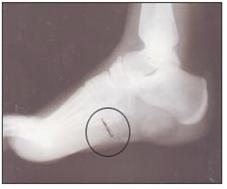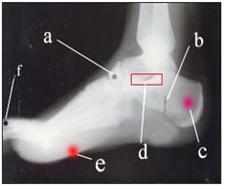족통(발이 아플 때) Foot pain
- 아이들은 족통을 흔히 호소한다.
- 아이들의 족통의 원인은 나이에 따라 많이 다를 수 있다.
- 아이들은 나이에 따라 육체적 활동과 운동의 종류에 차이가 있다.
- 그 차이에 따라 발에 생기는 외상의 종류와 정도가 다를 수 있고,
- 족통의 정도도 차이가 날 수 있다.
- 발에 있는 족근골, 중수골, 족지골 등의 뼈에 손상이 생길 수 있고,
- 발에 있는 건, 인대·활막 손상이나 근육 손상이 있으면 발이 아플 수 있다.
- 0~6세 영유아들의 족통은 발을 너무 많이 쓰거나 심한 운동, 외상, 잘 맞지 않는 신발, 발의 이물, 발뼈 골절, 발뼈 골수염, 연소성 류마토이드 관절염, 류마티스 관절염, 발뼈의 골 낭종 등으로 생길 수 있다.
- 6~12세 학령기 아이들의 족통은 발을 너무 많이 쓰거나 운동을 너무 많이 할 때,
- 외상, 잘 맞지 않는 신발, 발의 이물, 발 뼈 골절, 발 뼈 골수염, 부 주상골, 발 뼈 관절염, 지조내생,
- 발에 난 종양, 티눈, 발 사마귀, 발 관절 삠, 골 낭종 등으로 생길 수 있다.
- 12~18세 사춘기 아이들의 족통은 발을 너무 많이 쓰거나 운동을 심하게 할 때, 외상, 신발이 맞지 않을 때, 발 이물, 지조내생, 발의 아치가 비정상적으로 너무 높을 때나 편평족이 있을 때, 부 주상골, 쾰러골병, 아킬레스 인대 이상, 발목 관절이 삘 때, 발 뼈 골절, 종양, 티눈, 발 사마귀, 골 낭종 등으로 생길 수 있다.
족통(발이 아플 때)의 진단 치료
-
원인에 따라 진단할 수 있다.
-
외상 등으로 족통이 생길 때는 병력과 증상 징후 진찰소견을 종합해서 진단할 수 있다.
-
필요에 따라 발 X선 사진 검사나 발 CT 스캔 검사, 또는 발 MRI 검사 등으로 진단하기도 한다. 치료는 원인에 따라 한다.

사진 332. ◯ 내 발에 박힌 이물로 족통이 생길 수 있다.
Copyright ⓒ 2011 John Sangwon Lee, M.D., FAAP

사진333. 발이 아픈 원인(족통의 원인)
a-부 주상골, b-발뼈 골절, c-발뼈 골수염, d □ 내 –발뼈 관절염, e-발의 외상, f-지조내생 등이다. Copyright ⓒ 2011 John Sangwon Lee, M.D., FAAP
Foot pain 족통(발이 아플 때)
• Children often complain of foot pain.
• The causes of foot pain in children can vary greatly depending on their age.
• Children have different types of physical activity and exercise according to their age.
• Depending on the difference, the type and degree of trauma to the foot may vary;
• The degree of foot pain may also vary.
• Damage to the bones of the foot, such as the tarsal bones, metacarpals, and phalanges, may occur.
• Damage to tendons, ligaments, synovial membranes, or muscle in the foot can cause pain.
• Foot pain in infants and toddlers aged 0 to 6 years old can be caused by excessive foot use, excessive exercise, trauma, poorly fitting footwear, the foreign body of the foot, foot bone fracture, osteomyelitis of the foot, juvenile rheumatoid arthritis, rheumatoid arthritis, or bone cyst of the foot bone.
• Foot pain in 6-12-year-old school-age children occurs when they use their feet too much or exercise too much.
• Trauma, poorly fitting footwear, the foreign body of the foot, foot bone fracture, foot bone osteomyelitis, scaphoid bone, foot osteoarthritis,
• It can be caused by tumors on the feet, corns, foot warts, sprained feet, or bone cysts.
• Foot pain in adolescent children aged 12 to 18 years of age occurs when the feet are used too much or when they exercise too much, when they are traumatized when shoes do not fit, when they are foreign when the arch of the foot is abnormally high when there is flatfoot when there is a paranavicular bone. , Kohler’s disease, Achilles ligament abnormality, sprained ankle joint, foot bone fracture, tumor, corn, foot wart, bone cyst, etc.
Diagnosis and treatment of foot pain (when your feet hurt)
• Diagnosis can be made according to the cause.
• When foot pain occurs due to trauma, etc., the diagnosis can be made by combining the medical history and symptoms, signs, and examination findings.
• If necessary, diagnosis may be made by an X-ray examination of the foot, a CT scan of the foot, or an MRI examination of the foot. Treatment depends on the cause.

Picture 332. ◯ A foreign body stuck in my foot may cause foot pain. Copyright ⓒ 2011 John Sangwon Lee, M.D., FAAP

Picture 333. Causes of foot pain (causes of foot pain) a-scaphoid bone, b-foot bone fracture, c-foot osteomyelitis, d □, inner-foot osteoarthritis, e-foot trauma, f-articular endogenesis, etc. Copyright ⓒ 2011 John Sangwon Lee, M.D., FAAP
출처 및 참조 문헌 Sources and references
- NelsonTextbook of Pediatrics 22ND Ed
- The Harriet Lane Handbook 22ND Ed
- Growth and development of the children
- Red Book 32nd Ed 2021-2024
- Neonatal Resuscitation, American Academy Pediatrics
- www.drleepediatrics.com 제16권 소아청소년 정형외과 질환
- www.drleepediatrics.com제8권 소아청소년 호흡기 질환
- www.drleepediatrics.com제9권 소아청소년 소화기 질환
- www.drleepediatrics.com제10권. 소아청소년 신장 비뇨 생식기 질환
- www.drleepediatrics.com제11권. 소아청소년 심장 혈관계 질환
- www.drleepediatrics.com제12권. 소아청소년 신경 정신 질환, 행동 수면 문제
- www.drleepediatrics.com제13권. 소아청소년 혈액, 림프, 종양 질환
- www.drleepediatrics.com제14권. 소아청소년 내분비, 유전, 염색체, 대사, 희귀병
- www.drleepediatrics.com제15권. 소아청소년 알레르기, 자가 면역질환
- Red book 29th-31st edition 2021
- Nelson Text Book of Pediatrics 19th — 21st Edition
- The Johns Hopkins Hospital, The Harriet Lane Handbook, 22nd edition
-
Childhood Emergencies in the Office, Hospital and Community, American Academy of Pediatrics
-
Emergency Medical Service for Children, By Ross Lab. May 1989. p.10
-
Emergency care, Harvey grant, and Robert Murray
-
Emergency Care Transportation of Sick and Injured American Academy of Orthopaedic Surgeons
-
Emergency Pediatrics A Guide to Ambulatory Care, Roger M. Barkin, Peter Rosen
-
Immediate care of the acutely ill and injured, Hugh E. Stephenson, Jr
-
The Critically Ill Child, Diagnosis and Management, Edited by Clement A. Smith
-
Emergency Medical Services for Children: The Role of the Primary Care Provider, America Academy of Pediatrics
-
Quick Reference To Pediatric Emergencies, Delmer J. Pascoe, M.D., Moses Grossman, M.D. with 26 contributors
-
Manual of Emergency Care 응
-
급환자관리 정담미디어
-
소아가정간호백과–부모도 반의사가 되어야 한다, 이상원
-
Neonatal Resuscitation American heart Association
-
Neonatology Jeffrey J.Pomerance, C. Joan Richardson
-
Pediatric Resuscitation Pediatric Clinics of North America, Stephen M. Schexnayder, M.D.
-
Pediatric Critical Care, Pediatric Clinics of North America, James P. Orlowski, M.D.
-
Preparation for Birth. Beverly Savage and Dianna Smith
- Infectious disease of children, Saul Krugman, Samuel L Katz, Ann A. Gershon, Catherine Wilfert
-
The Harriet Lane Handbook 19th Edition
-
소아과학 대한교과서
-
제1권 소아청소년 응급의료 참조문헌과 출처
-
Other
Copyright ⓒ 2015 John Sangwon Lee, MD., FAAP
“부모도 반의사가 되어야 한다”-내용은 여러분들의 의사로부터 얻은 정보와 진료를 대신할 수 없습니다.
“The information contained in this publication should not be used as a substitute for the medical care and advice of your doctor. There may be variations in treatment that your doctor may recommend based on individual facts and circumstances. “Parental education is the best medicine.”